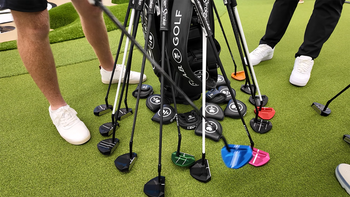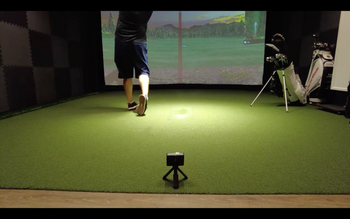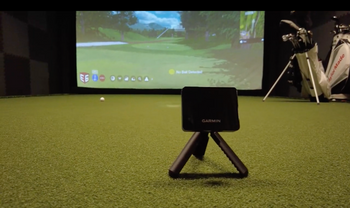Golf simulators will change the way you practice with five amazing benefits. You'll get instant feedback from high-speed cameras and sensors that track everything about your swing - from how fast your club's moving to how much spin you're putting on the ball. Since you can practice any time (rain or shine), you won't have to worry about weather getting in the way of improving your game. Plus, you'll get training programs that actually adjust to how you're playing and progressing. The detailed stats help you spot patterns and show you exactly what needs work, and practicing in a controlled space lets you work on your mental game without feeling pressured on the course. With all this tech at your fingertips, you're well on your way to shooting better scores.
Instant Feedback and Analysis
If you're serious about improving your golf game, you'll love how golf simulators give you instant, data-driven feedback. Thanks to their network of sensors and high-speed cameras, you'll get detailed insights about every part of your swing - from club head speed to ball spin rate. This helps you make adjustments on the spot that you'd never catch just by watching yourself.
What's great is that the simulator's data takes all the guesswork out of your practice sessions. Instead of scratching your head wondering why your shots are slicing or hooking, you'll see exactly what's happening with your swing path, launch angle, and club face at impact. This clear feedback helps you practice smarter, not harder, and keeps you from developing bad habits. Plus, since you can practice in any weather, you won't have to skip sessions because of rain or cold. Try to get in three practice sessions a week with focused drills for the best results.
The best part? You can look back at all your data to spot patterns and see how you're improving. Whether you're trying to add yards to your drive or dial in your approach shots, getting instant feedback helps you learn faster than old-school practice methods. You'll see results sooner, and you'll know exactly what's working and what isn't.
Practice Any Time, Anywhere

Getting better at golf's mental game is just as important as improving your swing, and simulators are perfect for working on both. As you practice regularly, you'll get better at visualizing your shots, develop a pre-shot routine that works for you, and build mental toughness that'll help you on the actual course. Plus, the simulator gives you data about your swing that'll boost your confidence as you see yourself improving.
The simulator's controlled environment is great for creating your own "think box" - a mental space where you'll make all your shot decisions before hitting the ball. When you're practicing tough shots, you'll build confidence by working through pressure situations without the stress of being on a real course. Setting goals you can actually achieve during your simulator sessions helps keep you motivated to improve.
It's really helpful that the simulator gives you instant feedback. This keeps you focused on specific improvements instead of getting stuck in your head with too many swing thoughts.
One of the best things about using a simulator is how it helps you manage what you expect from yourself and develop a consistent mental approach. When you practice visualization and keep your emotions in check during virtual rounds, you're building habits that'll help you stay cool under pressure on the real course.
Mental Game Development
You'll love how modern golf simulators can help you improve your game with personalized training that combines smart analytics with custom instruction. Your instructor will use cool tools like launch monitors and data to create a training plan that's perfect for your swing style and what you want to achieve - whether that's hitting longer drives or nailing your short game.
The simulator keeps track of everything about your swing, from how you move the club to how much spin you put on the ball. This gives you real numbers to see how you're improving. Plus, since you're inside, you don't have to worry about rain or wind messing up your practice.
One of the best parts is how this tech works together with fitness training. You'll do exercises specifically designed for golf that help build your strength and form. As you get better, your instructor will adjust your program to keep you moving forward. It's a complete approach that really works!
Personalized Training Programs
You'll love how modern golf simulators can help you improve your game with personalized training that combines smart analytics with custom instruction. Your instructor will use cool tools like launch monitors and data to create a training plan that's perfect for your swing style and what you want to achieve - whether that's hitting longer drives or nailing your short game.
The simulator keeps track of everything about your swing, from how you move the club to how much spin you put on the ball. This gives you real numbers to see how you're improving. Plus, since you're inside, you don't have to worry about rain or wind messing up your practice.
One of the best parts is how this tech works together with fitness training. You'll do exercises specifically designed for golf that help build your strength and form. As you get better, your instructor will adjust your program to keep you moving forward. It's a complete approach that really works!
Advanced Data-Driven Learning

Golf simulators are changing the way we learn by turning every swing into useful data. They use high-speed cameras and motion sensors to give you instant feedback on everything from your club speed to your attack angle and face angle, making it easier to perfect your technique.
You're not just mindlessly hitting balls at a screen anymore. Instead, you're getting valuable data that'll help you practice smarter. The simulator shows and tells you exactly what's happening with your swing, and you can watch in real-time how the ball flies based on your adjustments.
One of the best parts is how it keeps track of your progress. You'll see detailed trends that show what you're doing well and what needs work.
But here's what really makes these simulators special - they feel just like playing on a real course. They factor in everything from wind to green speeds. As you learn from your data, you'll make better choices about which clubs to use and how to play the course. Best of all, these improvements won't just stay in the simulator - they'll show up in your real game too.
Frequently Asked Questions
How Much Space Do I Need to Set up a Golf Simulator?
You'll want a decent-sized room for your golf simulator - aim for at least 10-12 feet wide, 15-18 feet deep, and 9-10 feet high to make it comfortable.
If you've got both righties and lefties playing, you should bump up the width to 14-16 feet to give everyone enough space.
Plan on leaving about 10-12 feet between your hitting mat and the screen. Don't forget to add another 2-3 feet behind you - you'll need that space for your backswing.
Just remember to factor in some extra room for your launch monitor and projector too. They'll need their own space to work properly.
Can Left-Handed Golfers Use the Same Simulator Setup as Right-Handed Players?
You'll be happy to know that you can use the same golf simulator whether you're left or right-handed - you just need enough space and the right gear.
If you're using overhead systems like the Uneekor EYE XO or radar units like Trackman, you won't need to change anything - they work great for both lefties and righties.
Just keep in mind that with some launch monitors (like SkyTrak), you'll need to move things around when switching between left and right-handed play.
Make sure your room's at least 15 feet wide so everyone can swing comfortably, no matter which hand they use.
What Is the Typical Lifespan of a Golf Simulator System?
Just like your car, how long your golf simulator lasts really comes down to how well you take care of it.
If you've got a high-end system and you're looking after it properly, you'll usually get 5-10 years out of it. Mid-range setups typically run for 4-6 years. It all depends on how often you're using it, how well you maintain it, and where you keep it set up.
Running a commercial system? You're looking at 5-8 years of heavy use. But if it's just for your home, you can easily get 10 years out of it if you're keeping up with the maintenance.
Do Golf Simulators Work With All Types of Clubs and Balls?
You'll be happy to know that most golf simulators work great with any standard clubs and balls - though you'll definitely get better results if you use regular golf balls instead of practice ones.
Some fancy launch monitors like Uneekor and SkyTrak do need special reflective stickers on your clubs to track things better. And if you're looking for the most accurate readings, you might want to try balls like Titleist RCT, which are specially made with radar-reflective tech to work with simulators.
How Accurate Are Golf Simulators Compared to Real-World Play?
Modern high-end golf simulators are incredibly accurate, matching up to 97.8% with real-world play. They use cool tech like high-speed cameras and infrared sensors to track your shots.
You'll be amazed at how precisely they measure things like ball speed, launch angle, and spin rates. While it won't feel exactly like hitting balls outside, and you won't get those changing weather conditions, it's pretty darn close.
Sure, it's not perfectly like playing outdoors, but today's simulators are so good you might forget you're inside!
Conclusion
It's like having your own golf coach who's available 24/7 - that's what today's golf simulators can do for your game. Whether you're trying to fix your swing, sharpen your focus, or dive into your shot stats, these smart training tools give you amazing ways to get better. You'll notice that putting in regular practice time with a simulator, and using all the feedback it gives you, can really step up your game - from the first drive to the last hole.





